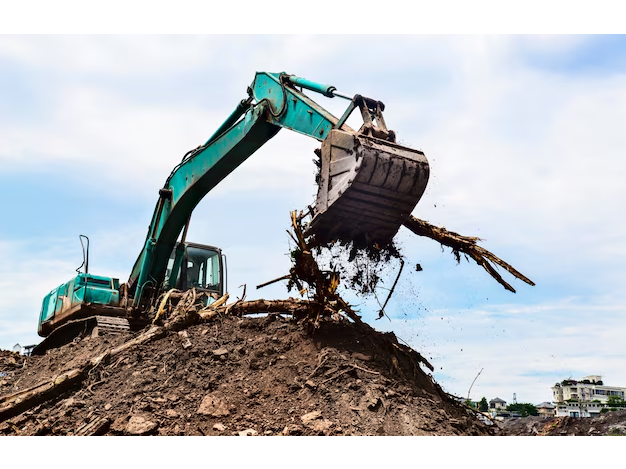Categories more
- Adventures (17)
- Arts / Collectables (15)
- Automotive (37)
- Aviation (11)
- Bath, Body, & Health (77)
- Children (6)
- Cigars / Spirits (32)
- Cuisine (16)
- Design/Architecture (22)
- Electronics (13)
- Entertainment (4)
- Event Planning (5)
- Fashion (46)
- Finance (9)
- Gifts / Misc (6)
- Home Decor (45)
- Jewelry (41)
- Pets (3)
- Philanthropy (1)
- Real Estate (16)
- Services (23)
- Sports / Golf (14)
- Vacation / Travel (60)
- Watches / Pens (15)
- Wines / Vines (24)
- Yachting / Boating (17)
Revolutionizing Construction Sites with Ergonomic and Durable Machinery
Published
12/28/2024Modern construction demands efficiency, safety, and comfort for operators, along with equipment that can withstand the rigors of challenging environments. Ergonomic and durable machinery is revolutionizing how construction projects are executed, enhancing productivity while prioritizing the well-being of workers. This article delves into how innovative design and robust engineering are transforming construction sites.
The Role of Ergonomics in Construction Machinery
Why Ergonomics Matter
Ergonomics focuses on designing equipment that aligns with the physical capabilities and needs of operators. In construction, where tasks are often physically demanding, ergonomic machinery plays a pivotal role in:
- Reducing operator fatigue.
- Minimizing the risk of workplace injuries.
- Enhancing overall productivity.
Key Ergonomic Features
- Comfortable Cab Designs: Spacious cabins with adjustable seating and ample legroom ensure operators can work for extended periods without discomfort.
- Intuitive Controls: User-friendly dashboards and touchscreen interfaces simplify operations, reducing the learning curve and potential errors.
- Climate Control Systems: Heating and cooling features maintain a comfortable working environment, even in extreme weather conditions.
- Vibration and Noise Reduction: Advanced suspension systems and soundproof cabins create a quieter, smoother experience for operators.
Durability: The Backbone of Modern Machinery
Why Durability Is Critical
Durable construction equipment is essential for tackling challenging environments, such as rocky terrains, muddy worksites, and extreme weather conditions. A robust hydraulic breaker not only ensures consistent performance but also minimizes downtime caused by breakdowns.
Features That Enhance Durability
- High-Quality Materials: Machines built with reinforced steel and wear-resistant components can withstand heavy-duty use over time.
- Advanced Hydraulic Systems: Durable hydraulics maintain consistent power delivery, even under high pressure and demanding workloads.
- Protected Components: Shielded engine compartments and hoses prevent damage from debris, weather, and impact during operation.
- Easy Maintenance Access: Features like wide hood openings and centralized lubrication points simplify upkeep, extending the life of the equipment.
How Ergonomics and Durability Boost Productivity
Operator Efficiency
Ergonomic designs keep operators comfortable and focused, reducing errors and enhancing precision. Features like intuitive controls and adjustable settings enable workers to adapt machines to specific tasks quickly.
Minimized Downtime
Durable equipment reduces the frequency of repairs and replacements. Machines that require less maintenance and can endure heavy use keep projects running on schedule.
Safety Enhancements
Ergonomic designs and robust construction contribute to safer job sites. By prioritizing operator comfort and equipment reliability, the risk of accidents and injuries is significantly reduced.
Innovations Driving the Revolution
Smart Technology Integration
Modern machinery often includes intelligent features that enhance both ergonomics and durability:
- Telematics: Real-time monitoring of machine performance and maintenance needs help prevent unexpected breakdowns.
- Customizable Controls: Operators can pre-set controls for specific tasks, streamlining operations and reducing strain.
- Automation: Semi-automated features, such as self-leveling arms or GPS guidance, improve precision and ease operator workload.
Energy Efficiency
Durable machines with energy-efficient systems consume less fuel, reducing operational costs and environmental impact. Hydraulic systems with adjustable flow rates and idle-reduction technology contribute to a greener construction process.
Adaptability
Equipment designed to accommodate multiple attachments increases versatility and durability. Machines that can seamlessly switch between tools, such as buckets, graders, and trenchers, are better equipped to handle diverse projects.
Real-World Applications
Urban Construction
In densely populated areas, machines with ergonomic designs and reduced noise levels ensure minimal disruption to surrounding communities while keeping operators comfortable during long hours.
Heavy-Duty Projects
Durable equipment is essential for large-scale projects, such as road construction or mining, where machinery is exposed to heavy loads and challenging terrain.
Cold Climate Operations
In extreme cold, machines with heated cabs and robust materials maintain performance and protect operators from harsh weather conditions.
Choosing the Right Equipment
When selecting ergonomic and durable machinery, consider the following:
- Operator Needs: Prioritize features that enhance comfort and safety, such as adjustable seats and user-friendly controls.
- Project Demands: Assess the environmental challenges and task requirements to choose equipment with the appropriate durability features.
- Maintenance Support: Opt for machines supported by reliable service networks to ensure long-term performance.
The Future of Construction Machinery
As technology continues to evolve, ergonomic and durable machinery will only become more advanced. Anticipated trends include:
- Wearable Tech Integration: Operators may use wearable devices to monitor health metrics and optimize comfort settings in real time.
- AI-Powered Features: Artificial intelligence could further automate routine tasks, reducing operator workload.
- Eco-Friendly Materials: Sustainable construction will drive the adoption of materials and systems that enhance durability while minimizing environmental impact.
Conclusion
Ergonomic and durable machinery is reshaping construction sites by combining operator comfort with long-lasting performance. These innovations not only boost productivity but also prioritize the safety and well-being of workers. By investing in heavy equipment that aligns with modern construction demands, project managers can achieve greater efficiency and deliver superior results.















